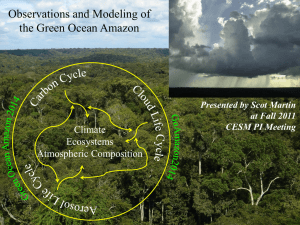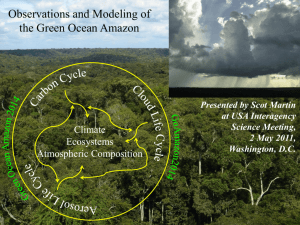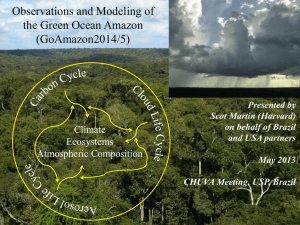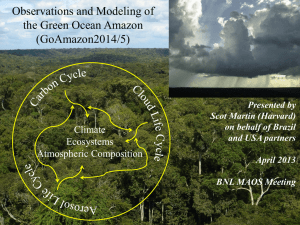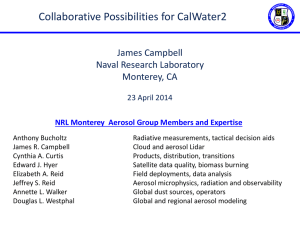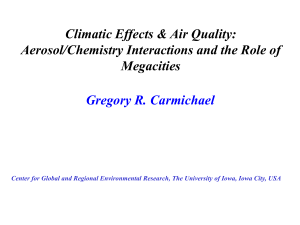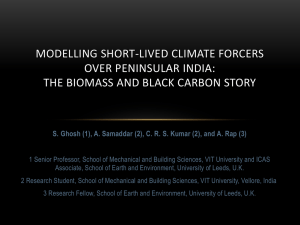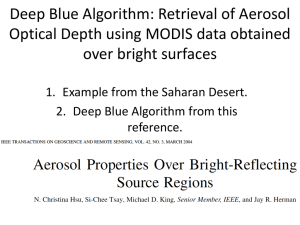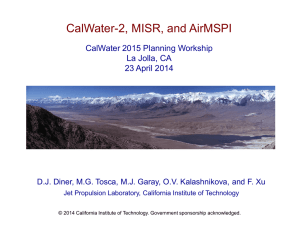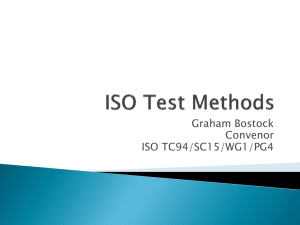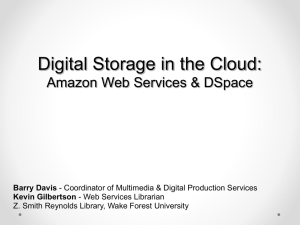Overview Presentation
advertisement
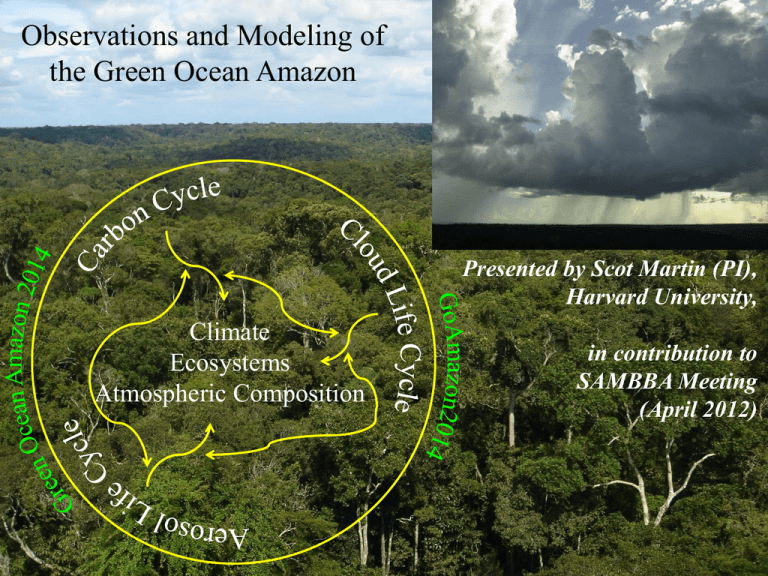
Observations and Modeling of the Green Ocean Amazon Presented by Scot Martin (PI), Harvard University, Climate Ecosystems Atmospheric Composition in contribution to SAMBBA Meeting (April 2012) Outline of Presentation • WHY this experiment, part 1? • WHERE will this experiment take place? • WHEN will this experiment take place? • WHAT instrumentation and facilities are part of experiment? • HOW is the experiment organized? • WHY this experiment, part 2? Outline of Presentation • WHY this experiment, part 1? • WHERE will this experiment take place? • WHEN will this experiment take place? • WHAT instrumentation and facilities are part of experiment? • HOW is the experiment organized? • WHY this experiment, part 2? Cloud Life Cycle, Aerosol Life Cycle, Aerosol-CloudPrecipitation Interactions, Carbon Cycle are all represented in this schematic. GoAmazon2014: What is the effect of pollution on… these cycles and the coupling among them? Source: Pöschl, Martin, et al., "Rainforest aerosols as biogenic nuclei of clouds and precipitation in the Amazon," Science, 2010, 329, 1513-1516. Example: Sensitivity of Cloud Droplet Number Concentration (CDNC) to Pollution (aka “Aerosol Indirect Effects”) Amazon Basin: Low aerosol number concentrations + High water vapor concentration = Amazon Basin; Year 1750 Especially susceptible. Anthropogenically affected continents; Year 2012 Possibility of dramatic changes in energy flows and rainfall patterns Reference: Pöschl, Martin, et al., “Rainforest aerosols as biogenic nuclei of clouds and precipitation in the Amazon,” Science, 2010, 329, 1513-1516. Outline of Presentation • WHY this experiment, part 1? • WHERE will this experiment take place? • WHEN will this experiment take place? • WHAT instrumentation and facilities are part of experiment? • HOW is the experiment organized? • WHY this experiment, part 2? Downwind of Manaus •111 by 60.8 km represented by this box. •Wind speeds at 1 km altitude are typically 10 to 30 kph. •T2→T3 transit time of 2 to 6 hr. Reference: Kuhn, U.; Ganzeveld, L.; Thielmann, A.; Dindorf, T.; Welling, M.; Sciare, J.; Roberts, G.; Meixner, F. X.; Kesselmeier, J.; Lelieveld, J.; Ciccioli, P.; Kolle, O.; Lloyd, J.; Trentmann, J.; Artaxo, P.; Andreae, M. O., “Impact of Manaus City on the Amazon Green Ocean atmosphere: Ozone production, precursor sensitivity, and aerosol load,” Atmos. Chem. Phys. 2010, 10, 9251-9282. Reference: Kuhn, U.; Ganzeveld, L.; Thielmann, A.; Dindorf, T.; Welling, M.; Sciare, J.; Roberts, G.; Meixner, F. X.; Kesselmeier, J.; Lelieveld, J.; Ciccioli, P.; Kolle, O.; Lloyd, J.; Trentmann, J.; Artaxo, P.; Andreae, M. O., “Impact of Manaus City on the Amazon Green Ocean atmosphere: Ozone production, precursor sensitivity, and aerosol load,” Atmos. Chem. Phys. 2010, 10, 9251-9282. Downwind of Manaus The deployment site is situated in the steady trade winds such that it experiences the extremes of: (i) a pristine atmosphere when the Manaus pollution plume meanders; and (ii) heavy pollution and the interactions of that pollution with the natural environment when the plume regularly intersects the site. Reminder: GoAmazon2014 Theme: What is the effect of pollution on… these cycles and the coupling among them? December 2011: Fence and Weather Station Outline of Presentation • WHY this experiment, part 1? • WHERE will this experiment take place? • WHEN will this experiment take place? • WHAT instrumentation and facilities are part of experiment? • HOW is the experiment organized? • WHY this experiment, part 2? Dates of GoAmazon2014 AMF Operations (T3 ground site) • 1 January until 31 December 2014 AAF Operations (aircraft) • 15 February until 26 March 2014 (wet season) (75 hrs) • 1 September until 10 October 2014 (dry season) (75 hrs) Aircraft operations correspond to the two intensive operating periods planned for the experiment. Outline of Presentation • WHY this experiment, part 1? • WHERE will this experiment take place? • WHEN will this experiment take place? • WHAT instrumentation and facilities are part of experiment? • HOW is the experiment organized? • WHY this experiment, part 2? ARM Mobile Facility in Amazônia (AMFA) AMF1 AMF1 – 7 x 20’ sea containers 1 full-time on-site technician Precision Spectral Pyranometer (PSP) x 2 Precision Infrared Radiometer (PIR) x 2 Shaded Black & White Pyranometer (B/W) Shaded Precision Infrared Pyrgeometer (PIR) Normal Incidence Pyrhiliometer (NIP) Infrared Thermometer (IRT) x 2 Multi-Filter Rotating Shadowband Radiometer (MFRSR) Narrow Field of View Zenith Radiometer (NFOV) Optical Rain Gauge (ORG) Anemometers (WND) Temperature/Relative Humidity Sensor (T/RH) Barometer (BAR) Present Weather Detector (PWD) Eddy Correlation Flux Measurement System (ECOR) Shortwave Array Spectrometer (SAS-He, SAS-Ze) LANL Solar Fourier Transform Spectrophotometer (FTS) (Dubey) (OCO-2 validation) Microwave Radiometer (MWR) Microwave Radiometer Profiler (MWRP) Microwave Radiometer 90/150 (MWR-HF) Doppler Lidar (DL) Ceilometer (CEIL) Balloon Borne Sounding System (BBSS) W-band ARM Cloud Radar - 95GHz (WACR) Ka-W Scanning ARM Cloud Radar (SACR) Atmospheric Emitted Radiance Interferometer (AERI) Total Sky Imager (TSI) Aerosol Observation System (AOS) CCNC PSAP Nephelometers X 2 Radar Wind Profiler – 1290MHz (RWP) Cimel Sunphotometer (CSPHOT) MAOS Mobile Aerosol Observing System (MAOS) – 2 x 20’ sea containers (MAOS-A & MAOS-C) 2 x full time post-docs (supplied by ARM) Guest operational personnel (approx. 5) SOnic Detection And Ranging (SODAR) System (1000 to 4000 Hz) Ultra-High Sensitivity Aerosol Spectrometer (enhanced) Dual Column Cloud Condensation Nuclei Counter (CCN) Single Particle Soot Photometer (SP2) Scanning Mobility Particle Sizer (SMPS) Photo-Acoustic Soot Spectrometer (PASS), 3 Wavelength Humidigraph (3 Relative Humidities with 3 single wavelength nephelometers) Humidigraph (Scanning Relative Humidity with 3 single wavelength nephelometers) Trace Gas Instrument System (Research-Grade) Particle Into Liquid Sampler-Ion Chromatography-Water Soluble Organic Carbon (PILS-IC-WSOC) Particle Soot Absorption Photometer (PSAP), 3 Wavelength Nephelometer, 3 Wavelength Condensation Particle Counter (CPC), 10 nm to >3000 nm particle size range Condensation Particle Counter (CPC), 2.5 nm to >3000 nm particle size range Hygroscopic Tandem Differential Mobility Analyzer (HTDMA) Proton Transfer Mass Spectrometer (PTRMS) 7-Wavelength Aethelometer Weather Transmitter (WXT-520) Aerosol Chemistry Speciation Monitor (ACSM) “Intensive Airborne Research in Amazonia 2014” (IARA-2014) The ARM Aerial Facility (AAF) in Brazil Brazil-Side Organizations • LBA - Large-Scale Biosphere Atmosphere Experiment, http://lba.inpa.gov.br/lba/ • INPA - National Institute for Research in the Amazon, http://www.inpa.gov.br/ • INPE - National Institute for Space Research, http://www.inpe.br/ingles/index.php • CTA - Department of Science and Aerospace Technology, http://www.cta.br/ • UEA - University of the State of Amazonas, http://www1.uea.edu.br/ • USP - University of São Paulo, http://www.thefullwiki.org/University_of_Sao_Paulo, http://web.if.usp.br/ifusp/, http://www.master.iag.usp.br/index.php?pi=N • Links to GPM-CHUVA (http://chuvaproject.cptec.inpe.br/portal/en/index.html), SAMBBA (http://www.ncas.ac.uk/fgam/index.php?option=com_content&task=view&id=194&Itemid=1), Andes-Amazon Initiative (http://www.moore.org/andes-amazon.aspx), Amazon-PIRE (http://www.amazonpire.org/) GoAmazon2014: Known and Planned Activities Cloud Life Cycle Project GPM-CHUVA Leader: Luiz Machado IARA: DOE AAF Deployment NASA Satellite Science Coordinators: Loretta Mickley and Jun Wang iLEAPS IGAC ACPC Point of contact: Meinrat Andreae AMFA: DOE AMF Deployment Aerosol-CloudPrecipitation Interactions Aeroclima An Aerosol Life Cycle Project T2 → T3 Lagrangian experiment accompanying IARA Coordinator: Jian Wang Leader: Paulo Artaxo Cloud Life Cycle Project NSF EOL/SPO Facilities S-POL Leader: Courtney Schumacher Aerosol Life Cycle Project BEACHON Leader: Alex Guenther More activities evolving (some DOE, some not DOE): GECO: DOE TES Deployment Leader: Jeffrey Chambers Cloud Life Cycle, Aerosol-CloudPrecipitation Interactions, Carbon Cycle, international partners, … Outline of Presentation • WHY this experiment, part 1? • WHERE will this experiment take place? • WHEN will this experiment take place? • WHAT instrumentation and facilities are part of experiment? • HOW is the experiment organized? • WHY this experiment, part 2? Scientific Questions for GoAmazon2014 Note: Non-exhaustive selected list. Further development anticipated. Carbon Cycle - improve Community Earth System Model (CESM) for land-atmosphere processes in the Amazon Basin, including aerosol-cloud-precipitation connections • Objective - Reduce uncertainties in our knowledge of feedbacks between vegetationhydrology that underlie the Amazon forest dieback hypothesis. The uncertain range of feedbacks at present leads to large differences in ESM predictions. • Objective - Response of photosynthesis and transpiration, including BVOC emissions, to changes in the direct and diffuse components of incoming solar radiation, i.e., in the context of current and future scenarios of aerosols and clouds in the Amazon Basin. Aerosol Life Cycle - accurate modeling of aerosol sources/sinks and aerosol optical, CCN, and IN properties, as affected by pollution of pristine tropical environments • Objective - The interactions of the urban pollution plume with biogenic volatile organic compounds in the tropics, especially the impact on the production of secondary organic aerosol, the formation of new particles, and biogenic emissions of aerosols and their precursors.. precursors. • Objective - Influence of anthropogenic activities on aerosol microphysical, optical, cloud condensation nuclei (CCN), and ice nuclei (IN) properties in the tropics. Scientific Questions for GoAmazon2014 Note: Non-exhaustive selected list. Further development anticipated. Cloud Life Cycle - development of a knowledge base to improve tropical cloud parameterizations in GCMs • Objective - The transition from shallow to deep cumulus convection during the daily cycle of the Amazon Basin, with comparison and understanding to other environments. • Objective - The role of landscape heterogeneity—the Manaus urban area as well as the 10-km-scale of river width—on the dynamics of convection and clouds (+carbon cycle) • Objective - The evolution of convective intensity from severe storms in the dry season to moderate storms in the wet season. Cloud-Aerosol-Precipitation Interactions - improvement of parameterizations of aerosol-cloud interactions in climate models • Objective - Aerosol effects on deep convective clouds, precipitation, and lightning under different aerosol and synoptic regimes, including the roles of aerosols in changing regional climate and atmospheric circulation. • Objective - Data-driven improvement of parameterizations of aerosol-cloud interactions in the climate models. Outline of Presentation • WHY this experiment, part 1? • WHERE will this experiment take place? • WHEN will this experiment take place? • WHAT instrumentation and facilities are part of experiment? • HOW is the experiment organized? • WHY this experiment, part 2? An Aerosol Life Cycle Project T2 → T3 Lagrangian experiment accompanying IARA A more detailed example: What we learned in AMAZE-08 and what we hope to learn in GoAmazon2014 Amazonian Aerosol Characterization Experiment (AMAZE-08) Wet Season of Central Amazônia in January – March 2008 S.T. Martin, M.O. Andreae, D. Althausen, P. Artaxo, H. Baars, S. Borrmann, Q. Chen, D.K. Farmer, A. Guenther, S. Gunthe, J.L. Jimenez, T. Karl, K. Longo, A. Manzi, T. Pauliquevis, M. Petters, A. Prenni, U. Pöschl, L.V. Rizzo, J. Schneider, J.N. Smith, E. Swietlicki, J. Tota, J. Wang, A. Wiedensohler, S.R. Zorn, "An Overview of the Amazonian Aerosol Characterization Experiment 2008 (AMAZE-08)," Atmospheric Chemistry Physics, 2010, 10, 11415-11438 Atmospheric Oxidants react with the Biogenic Emissions α-Pinene C10H16 OH NO3 O3 Isoprene C5H8 β-Caryophyllene C15H24 Secondary Organic Material (SOM) Contributes to Particle Growth High-volatility molecules in gas phase Low-volatility molecules in particle phase Similarity Between Mass Spectra Observed in AMAZE-08 and SOA Particles Generated in Environmental Chamber AMAZE-08 in Central Amazonia Harvard Environmental Chamber SOA Particles of Ozonized α-Pinene Adapted from Chen et al., Geophys. Res. Lett., 2009, 36, L20806 and Shilling et al., Atmos. Chem. Phys., 2009, 9, 771-782. High-Resolution Mass Spectra 0.15 Q-AMS Quadrupole C-ToF C-ToF-AMS V-ToF V-mode HR-ToF-AMS W-ToF W-mode HR-ToF-AMS 0.10 42.5 43.0 43.5 0.05 0.00 42.9 43.0 43.1 43.2 m/z C3H7 CHNO C2H3O C2H5N CH3N2 Q. Chen, D.K. Farmer, J. Schneider, S.R. Zorn, C.L. Heald, T.G. Karl, A. Guenther, J.D. Allan, N. Robinson, H. Coe, J.R. Kimmel, T. Pauliquevis, S. Borrmann, U. Poeschl, M.O. Andreae, P. Artaxo, J.L. Jimenez, and S.T. Martin, "Mass spectral characterization of submicron biogenic organic particles in the Amazon Basin," Geophysical Research Letters, 2009, 36, L20806. Dominance of Secondary Organic Material in Submicron Particles OH NO3 O3 1. SEM 2. AMS 3. CCN O:C of 0.4 to 0.5, consistent with chamber SOA particles Measured CCN activity Similarity of measured mass spectra to those accurately predicted using κorganic,SOA from lab chamber SOA particles results 4. AMS 5. AMS Absence of features for PBAPs But the chemistry can be completely shifted under anthropogenic influences… NOx concentration, SO2/H2SO4 particles Reference: Kuhn, U.; Ganzeveld, L.; Thielmann, A.; Dindorf, T.; Welling, M.; Sciare, J.; Roberts, G.; Meixner, F. X.; Kesselmeier, J.; Lelieveld, J.; Ciccioli, P.; Kolle, O.; Lloyd, J.; Trentmann, J.; Artaxo, P.; Andreae, M. O., “Impact of Manaus City on the Amazon Green Ocean atmosphere: Ozone production, precursor sensitivity, and aerosol load,” Atmos. Chem. Phys. 2010, 10, 9251-9282. But the chemistry can be completely shifted under anthropogenic influences… NOx concentration, SO2/H2SO4 particles HO2 NO2 RH OH R· O2 ROO· NO ROOH ROONO2 RO· RONO2 RO2 But the chemistry can be completely shifted under anthropogenic influences… NOx concentration, SO2/H2SO4 particles OH, O2 Isoprene Polluted Condition NO hydroxylnitrate hydroxycarbonyl Hydroxy-peroxy radical (8 isomers) HO2 Pristine Condition OH MVK MACR Hydroxyhydroperoxide and other hydroperoxides Dihydroxyepoxide Outline of Presentation • WHY this experiment, part 1? • WHERE will this experiment take place? • WHEN will this experiment take place? • WHAT instrumentation and facilities are part of experiment? • HOW is the experiment organized? • WHY this experiment, part 2? Join this Google group to receive email from PI: http://groups.google.com/group/GoAmazon2014 Websites: DOE maintained: http://campaign.arm.gov/goamazon2014/. See there a workshop report of July 2011. PI maintained: http://www.seas.harvard.edu/environmentalchemistry/GoAmazon2014/
